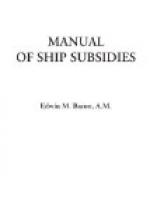* * * * *
The Kingdom of Hungary grants bounties to Hungarian ships, or ships owned in greater part by Hungarian subjects, independently of the Imperial Government. Her first general bounty law was also enacted in 1893 and was limited to ten years. The subsidies granted were of two classes—premium on purchase, and a mileage bounty. The purchase subsidy was based on net tonnage and was payable for a term of fifteen years from the date of the ship’s launching, reduced each succeeding year by seven per cent; the mileage subsidy, for the same term, was in proportion to the length of the voyages made “in the interest of national commerce whether to or from Hungarian ports.” The premiums on purchase were thus fixed for the first year: for vessels employed in long-distance coasting trade—sailing-ships, six krone (each 20 cents); steamers, nine krone per ton; employed in deep-sea trade,—sailing-ships, nine krone; steamers, twelve krone per ton. Iron or steel ships rated first class were entitled to these bounties. The mileage subsidy was fixed at five hellers per ton, per hundred nautical miles run. It was offered only for voyages “to places where no company in receipt of State subsidies is obliged to maintain regular communications;” and it was not to be given for “petty coasting trade."[DK]
This law was succeeded by an act of 1895 granting construction bounties, with the intent of fostering domestic shipping and the use of domestic material. The rates were proportioned according to the amount of foreign or domestic material used, construction with domestic product receiving the highest bounty. These rates were: for iron or steel hulls, thirty to sixty krone per ton; for wooden ships, ten to twenty-five krone per ton; for engines and auxiliary machinery, ten to fifteen krone per ton of materials used; for boilers and pipes, six to ten krone per ton of material. The total amount to be paid out yearly was limited to the modest figure of two hundred thousand krone ($40,600).[DL]
The law of 1895 in reality was not effective, for ships of the Hungarian merchant marine continued to be built in foreign parts—mainly in British yards;[DK] and while the carrying capacity had considerably increased, the tonnage had continued to decline.[DK] By 1904 the situation had become so unsatisfactory that, as the American consul at Budapest wrote, the passing of a new navigation-development law by Hungary’s Parliament had, it was believed, become a pressing necessity.[DM]
* * * * *
In 1909 the Austrian Government guaranteed a maximum sum of one million crowns (approximating $200,000) annually to the Austro-American Shipping Company for their service between Trieste and Brazil and Argentine ports. Should the service tend successfully to promote home industries and agriculture, this subsidy was to be increased, the amount of increase to depend upon the amount of cargo carried in excess of a certain minimum. The contract was to run for fifteen years from January 1, 1910. The service, beginning with sailings three times a month, was to become weekly on January 1, 1911.[DN]




